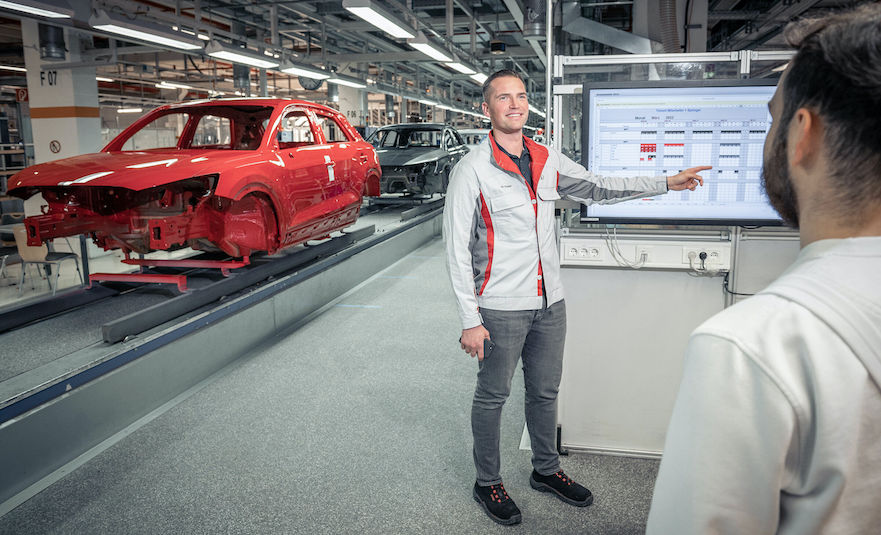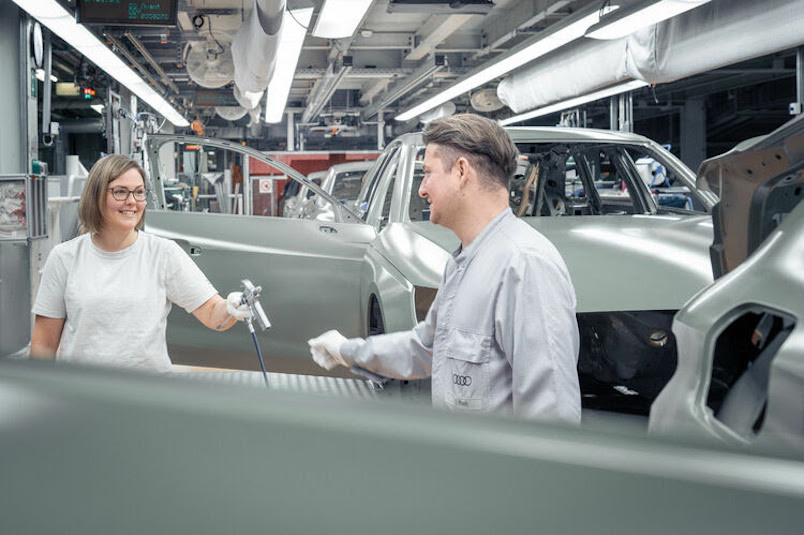 An innovative working-time model enables shift workers to also do part-time shifts in clocked vehicle production
An innovative working-time model enables shift workers to also do part-time shifts in clocked vehicle production
To advance an important idea and modern teamwork culture throughout the company
The pilot project is the only one of its kind in Germany and it is setting new standards
Shift work is well known for its rigidity. It sticks closely to a schedule that usually does not allow any flexibility at all. Employees who change to part-time work because of changes in their personal circumstances used to be required to transfer to new workplaces. But Audi has started a pilot project as part of its transformation and it has pioneering potential for flexible work in clocked car production.
An innovative work model in the paint shop at the Ingolstadt site allows shift workers to work part time as well. Audi employees from every position in the hierarchy and all age levels developed it together with the Works Council and the Institute for Social Science Research (ISF) Munich under the rubric of the Practical Workplace Laboratory: More Flexible on Shift Duty, which was supported by Germany’s Federal Ministry of Labour and Social Affairs.
Trained floaters fill in the gaps in time that arise due to the absence of part-time workers. Those floaters come from areas of the paint shop that are not on the clock, such as trainees, employees with limitations, or people who normally work in the office. If, for example, a new mother just back from maternity leave is a shift worker who cannot make it to work at the usual start time for her shift because she has to take her child to daycare first, a qualified colleague from the pool subs for the new mother. That way, the floater makes a later – and therefore a flexible – start time possible for the new mother.
As far as experts are currently aware, no other employer in Germany allows employees to help shape the future of their work this way. Accordingly, Audi Board Member for Human Resources Sabine Maassen has positive things to say about the new flexibility. “The initiative in our paint shop shows that the best ideas come from the company itself. It also shows that we put the person at the center – with his or her individual needs and competencies. That’s why we say we are advancing a modern teamwork culture for all our employees.”
Achim Heinfling, plant manager at Audi’s Ingolstadt site, agrees with her. He says that, “flexible working hours are far more difficult to implement in highly efficient, clocked car production than in a job that’s done at a desk. So I’m all the more excited that this unique pilot project is coming off with a lot of creativity and practical team spirit. We’re testing how far we can use the essential insights we gain from this for other manufacturing areas as well.”
Audi General Works Council chairman Peter Mosch emphasizes that “the work in the practical laboratory is about bringing together the experience and the knowledge of all the parties in the factory – the people who are affected directly, the Works Council, and management – in order to develop a workable solution that’s acceptable to everyone. It’s simply using collegial cooperation on equal terms to go beyond formal hierarchies. The experience we’ve gained here shows that methods like the ones developed at ISF’s practical laboratory are also highly valuable in other areas at Audi and for other companies. One precondition for that is a modern, co-determined, and participation-oriented culture of collaboration and training.”
The innovative working-time model for flexible shift work is still a pilot project that 16 employees currently benefit from. At the moment, 30 colleagues are in the pool. Audi plans to expand working-time models like the one used in the paint shop in other areas of production as well. That is because the process of making work flexible is well underway at the company with the four rings – in the office as well as in production. Innovative projects like this not only make work and family more compatible for all our employees, but also create more visibility and recognition for part-time employees and managers.































